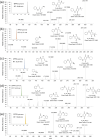New Evidence of Rubber-Derived Quinones in Water, Air, and Soil
- PMID: 35316033
- PMCID: PMC8988306
- DOI: 10.1021/acs.est.1c07376
New Evidence of Rubber-Derived Quinones in Water, Air, and Soil
Abstract
p-Phenylenediamines (PPDs) have been extensively used in the rubber industry and found to be pervasive in various environmental compartments for decades, while their transformation products and associated ecological and human health risks remain largely unknown. Herein, we developed and implemented a mass spectrometry-based platform combined with self-synthesized standards for the investigation of rubber-derived quinones formed from PPD antioxidants. Our results demonstrated that five quinones are ubiquitously present in urban runoff, roadside soils, and air particles. All of the identified sources are closely related to mankind's activities. Among the identified quinones, N-(1,3-dimethylbutyl)-N'-phenyl-p-phenylenediamine quinone has been recently found to be highly toxic, causing acute mortality of coho salmon in the Pacific Northwest. Ultrahigh-performance liquid chromatography coupled with triple quadrupole mass spectrometry was then applied for quantification of the five quinones and their corresponding PPD antioxidants. The results revealed interesting distinct distribution and concentration patterns of PPD-derived quinones in different environmental matrices. Daily intake rates of these quinones in a compact city of Hong Kong were estimated to be varied from 1.08 ng/(kg·day) for adults to 7.30 ng/(kg·day) for children, which were higher than the exposure levels of their parent compounds. Considering the prevalence of the use of rubber products, the outcome of this study strongly suggests for additional toxicological studies to investigate potential ecological and human health risks of the newly discovered quinones.
Keywords: 6PPD-quinone; human health; p-phenylenediamines; rubber-derived quinones.
Conflict of interest statement
The authors declare no competing financial interest.
Figures



Similar articles
-
Widespread Occurrence and Transport of p-Phenylenediamines and Their Quinones in Sediments across Urban Rivers, Estuaries, Coasts, and Deep-Sea Regions.Environ Sci Technol. 2023 Feb 14;57(6):2393-2403. doi: 10.1021/acs.est.2c07652. Epub 2023 Jan 31. Environ Sci Technol. 2023. PMID: 36720114
-
Occurrence and Fate of Substituted p-Phenylenediamine-Derived Quinones in Hong Kong Wastewater Treatment Plants.Environ Sci Technol. 2023 Oct 17;57(41):15635-15643. doi: 10.1021/acs.est.3c03758. Epub 2023 Oct 5. Environ Sci Technol. 2023. PMID: 37798257 Free PMC article.
-
p-Phenylenediamines and p-phenylenediamine quinone derivatives in rubber consumer products and typical urban dust: Sources, transformation profiles, and health risks.Environ Int. 2024 Oct;192:109042. doi: 10.1016/j.envint.2024.109042. Epub 2024 Sep 30. Environ Int. 2024. PMID: 39362086
-
P-phenylenediamine antioxidants and their quinone derivatives: A review of their environmental occurrence, accessibility, potential toxicity, and human exposure.Sci Total Environ. 2024 Oct 20;948:174449. doi: 10.1016/j.scitotenv.2024.174449. Epub 2024 Jul 3. Sci Total Environ. 2024. PMID: 38969117 Review.
-
Environmental occurrence, fate, human exposure, and human health risks of p-phenylenediamines and their quinones.Sci Total Environ. 2024 Dec 20;957:177742. doi: 10.1016/j.scitotenv.2024.177742. Epub 2024 Nov 29. Sci Total Environ. 2024. PMID: 39608260 Review.
Cited by
-
Chronic toxicity mechanisms of 6PPD and 6PPD-Quinone in zebrafish.Environ Sci Ecotechnol. 2025 May 6;25:100567. doi: 10.1016/j.ese.2025.100567. eCollection 2025 May. Environ Sci Ecotechnol. 2025. PMID: 40488135 Free PMC article.
-
Investigation of 6PPD-Quinone in Rubberized Asphalt Concrete Mixtures.ACS Environ Au. 2023 Jul 26;3(6):336-341. doi: 10.1021/acsenvironau.3c00023. eCollection 2023 Nov 15. ACS Environ Au. 2023. PMID: 38028740 Free PMC article.
-
A review on recent advances in mass spectrometry analysis of harmful contaminants in food.Front Nutr. 2023 Aug 1;10:1244459. doi: 10.3389/fnut.2023.1244459. eCollection 2023. Front Nutr. 2023. PMID: 37593680 Free PMC article. Review.
-
A nanogold sensor test for tire wear chemicals based on the plasmon ruler approach.Mikrochim Acta. 2024 May 17;191(6):335. doi: 10.1007/s00604-024-06376-3. Mikrochim Acta. 2024. PMID: 38760484 Free PMC article.
-
The Invisible Footprint of Climbing Shoes: High Exposure to Rubber Additives in Indoor Facilities.ACS EST Air. 2025 Apr 24;2(5):930-942. doi: 10.1021/acsestair.5c00017. eCollection 2025 May 9. ACS EST Air. 2025. PMID: 40370931 Free PMC article.
References
-
- Bernhardt E. S.; Rosi E. J.; Gessner M. O. Synthetic chemicals as agents of global change. Front. Ecol. Environ. 2017, 15, 84–90. 10.1002/fee.1450. - DOI
-
- Homburg E.; Vaupel E.. Hazardous Chemicals: Agents of Risk and Change, 1800-2000; Berghahn Books, 2019; Vol. 17, pp 5–10.
-
- Moore M. N.Environmental Health Impacts of Natural and Man-Made Chemicals; Oxford University Press, 2019; pp 1–53.
-
- Tang F. H. M.; Lenzen M.; McBratney A.; Maggi F. Risk of pesticide pollution at the global scale. Nat. Geosci. 2021, 14, 206–210. 10.1038/s41561-021-00712-5. - DOI
Publication types
MeSH terms
Substances
LinkOut - more resources
Full Text Sources

